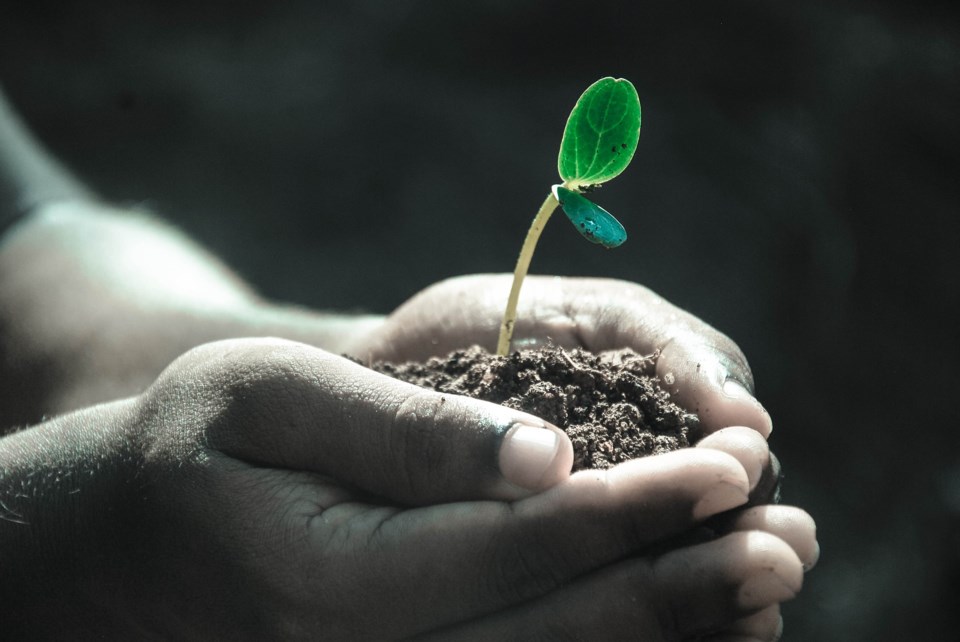Every week, Bowen Islanders ship our green waste off-island in big trucks. Every spring we pay to haul it back in big trucks and dump it on our gardens or future lawns. While many of us seem to love the organics program, others have worked hard on finding a better way by researching what a local green waste facility could look like. While Bowen Food Sovereignty would support this kind of action, we’d also like to see our friends and neighbours get as nerdy about soil as we are.
Did you know soils are some of the most biologically diverse habitats on the planet? In a healthy spoonful, you’re likely to find more than a billion different microbes. These microbes, which include bacteria and fungi and their microscopic predators, interact in all kinds of crazy ways. They release hormones and chemical signals to communicate with one another and with the plants they support. They can protect those plants from drought, and help them fight off harmful diseases. They work with nematodes (tiny worm-like things) and protozoa ( “micro-predators”) to process organic nutrients through the “soil food web” and consequently, to us.
Phil Gregory is the Bowen Food Sovereignty member with the most extensive scientific training. He is a retired UBC professor of physics and astronomy and until five years ago was focused on the discovery of exoplanets. Then, he turned his attention to life here on Earth, in Earth, actually.
“Plants and the other life forms in soil have developed a complex bartering system over 450 million years,” says Phil. “Plants give up to 40 per cent of the sugars they make to the soil microbes. In return, the microbes give the plants all the other elements they require. Most plant biologists believe that plants require 42 different elements. Conventional farming not only destroys this bartering system but it also largely relies on just three elements (nitrogen, phosphorus and potassium) to fulfill a plant’s nutritional requirements.”
If you happen to find yourself in conversation with Phil, he just might go on to tell you about the dire impacts eating these nutritionally deficient plants. The good news is that it is possible to grow food in a way that respects and even enhances the microbial life in soils. This is what regenerative agriculture is all about.
It’s a term you’re going to be hearing more in coming years because soil regeneration is a critical tool for fighting runaway global climate change. Soil holds more carbon than the earth’s atmosphere and all the organisms that live on this planet combined, but that tool for carbon sequestration is being lost to ploughs, chemicals, bulldozers and desertification.
Project Drawdown (an organization made up of researchers, scientists and policy makers whose mission it is to explain climate solutions in a way that “bridges the divide between urgency and agency”) acknowledges the importance of soil in its list of seventeen food and agriculture-related solutions. The French government looked to soil as a solution when they realized the talks international climate talks in 2015 were not going to deliver the required emissions cut. They launched an initiative known as 4 pour 1000, which invites stakeholders around the world “to transition towards a productive, highly resilient agriculture, based on the appropriate management of lands and soils, creating jobs and incomes, hence ensuring sustainable development.” The goal is to increase the amount of carbon stored in soils around the world by 0.4 per cent annually––and in doing so, significantly reduce the amount of carbon in the atmosphere related to human activities.
You might not know what to do with this information, because you live on an island covered in trees and you’re not a soil scientist or a farmer and that’s ok. We believe that simply understanding the impact of growing our food with care, attention and an ever-expanding love for the world beneath our feet can inspire truly positive action. How does our behaviour change when we understand our potential to be a help, instead of just a hindrance on this planet? Let’s repeat: we can actually help restore the balance of this out of control atmosphere we live in. Maybe we can restore balance in our own bodies while we’re at it.
Bowen Island Food Sovereignty is working on projects to move this restoration, or regeneration if you prefer, forward in our community. We’re starting small, and moving forward step by step. We don’t know where this is going, exactly, but we know we want you to join us.



